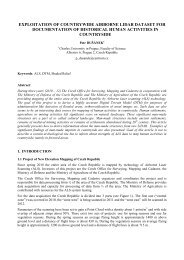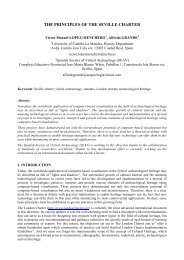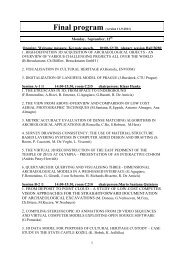Information management systems for cultural ... - CIPA - Icomos
Information management systems for cultural ... - CIPA - Icomos
Information management systems for cultural ... - CIPA - Icomos
You also want an ePaper? Increase the reach of your titles
YUMPU automatically turns print PDFs into web optimized ePapers that Google loves.
List. However, despite of this new approach, the elaboration and documentation of these serial transnational<br />
nomination dossiers in Central Asia still poses a number of problems and issues:<br />
(1) the large extent of the considered territory;<br />
(2) some of the inventory <strong>systems</strong>, e.g. Monument Passport as developed and used in the Soviet times, are<br />
standardized but are only available in hard copies and not much in<strong>for</strong>mation is digitized;<br />
(3) decision-makers are hardly acquainted with digital technology;<br />
(4) the lack of technical expertise in documentation and recording as well as monitoring of <strong>cultural</strong> heritage<br />
in all Central Asian countries except <strong>for</strong> Kazakhstan [8,9];<br />
(5) transnational collaboration is clear on paper but not in practice;<br />
(6) in some countries there is a lack of integrated <strong>management</strong> plans or <strong>systems</strong> and of conservation<br />
strategies [6,9].<br />
In dealing with these issues, the use of digital technology is a recommended cost-effective tool <strong>for</strong> better<br />
understanding and protection of serial transnational World Heritage properties [10]. <strong>In<strong>for</strong>mation</strong><br />
Management Systems (IMS) easily allow storing, managing, and monitoring the baseline in<strong>for</strong>mation during<br />
the elaboration of the nomination dossiers as well as after the properties are listed. Moreover, IMS ensure<br />
data integrity and improve quality control. Within this framework, UNESCO World Heritage Centre has<br />
allocated resources <strong>for</strong> underrepresented categories of properties and geographical regions to be technically<br />
supported during the nomination procedures in order to both, ensure the balance and credibility of the World<br />
Heritage List, and avoid the resubmission of nominations with incomplete files [11]. The Silk Roads serial<br />
transnational World Heritage nomination initiative is one of them.<br />
For the first phase of the Silk Roads serial transnational World Heritage nomination, two priority <strong>cultural</strong><br />
corridors in Central Asia and one in China were selected. To carry out this task, two projects will be working<br />
in conjunction, the Japanese Funds-in-Trust UNESCO project dealing with the support <strong>for</strong> documentation<br />
standards and procedures of the Silk Roads Serial and transnational World Heritage Nomination in Central<br />
Asia, and the Silk Roads Cultural Heritage Resources <strong>In<strong>for</strong>mation</strong> System (CHRIS) project.<br />
The Silk Roads CHRIS project is an UNESCO WHC initiative funded by the Belgian Federal Science Policy<br />
Office (BELSPO) and executed by a Belgian consortium headed by the Raymond Lemaire International<br />
Centre <strong>for</strong> Conservation at the K.U.Leuven supporting the Silk Roads serial transnational World Heritage<br />
nomination of the five Central Asian countries, namely, the Republics of Kazakhstan, Kyrgyzstan,<br />
Tajikistan, Turkmenistan and Uzbekistan. It aims to overcome the nomination issues based on the Central<br />
Asian user requirements by: (1) improving and automatizing the documentation processes, (2) crossreferencing<br />
data at national and transnational level with international standards, (3) developing and<br />
implementing an effective web-based license free multilingual plat<strong>for</strong>m <strong>for</strong> in<strong>for</strong>mation recording and<br />
sharing, (4) developing participatory editing tools with protected access rights, and (5) focusing on a thinclient<br />
approach <strong>for</strong> which no additional plug-ins are needed. Moreover, this user-friendly system will not<br />
require long trainings or specific qualifications <strong>for</strong> its use.<br />
The first demonstrator will be presented at the first documentation training in Uzbekistan to be evaluated by<br />
the Central Asian users in September 2011.<br />
3. THE SILK ROADS CHRIS APPROACH<br />
The Silk Roads CHRIS is a web-based collaborative plat<strong>for</strong>m in development that is user-oriented and based<br />
on the Operational Guidelines on the World Heritage Convention [1] and the approach of the UNESCO<br />
Chair in Preventive Conservation, Maintenance and Monitoring of the Monuments and Sites (PRECOMOS)<br />
[12].<br />
The system is accessible through standard Internet web browser allowing the implementation of a large<br />
number of actions and tools. It is based on “GIM Geo CMS” which is a combination of a Content<br />
Management System with a WebGIS application; and will be an evolution of the HERITECH IMS<br />
developed by GIM <strong>for</strong> the heritage managers of the City of Biograd na Moru in Croatia thanks to the support<br />
of the Flemish Government. This system shares the concepts of the Calakmul 4DGIS [13] developed in<br />
collaboration with UNESCO and with the financial support of BELSPO but is based on leading-edge<br />
technology. The Silk Roads CHRIS uses the geographical location of features of interest as common






